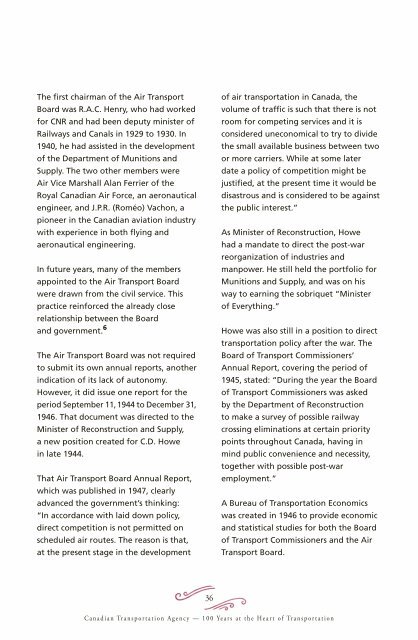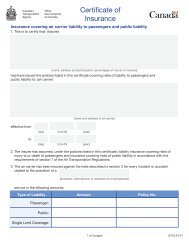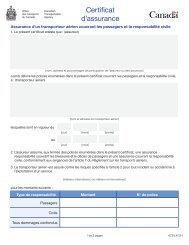The first chairman of the Air TransportBoard was R.A.C. Henry, who had workedfor CNR and had been deputy minister ofRailways and Canals in 1929 to 1930. In1940, he had assisted in the developmentof the Department of Munitions andSupply. The two other members wereAir Vice Marshall Alan Ferrier of theRoyal Canadian Air Force, an aeronauticalengineer, and J.P.R. (Roméo) Vachon, apioneer in the Canadian aviation in<strong>du</strong>strywith experience in both flying andaeronautical engineering.In future years, many of the membersappointed to the Air Transport Boardwere drawn from the civil service. Thispractice reinforced the already closerelationship between the Boardand government. 6The Air Transport Board was not requiredto submit its own annual reports, anotherindication of its lack of autonomy.However, it did issue one report for theperiod September 11,1944 to December 31,1946. That document was directed to theMinister of Reconstruction and Supply,a new position created for C.D. Howein late 1944.That Air Transport Board Annual Report,which was published in 1947, clearlyadvanced the government’s thinking:“In accordance with laid down policy,direct competition is not permitted onsche<strong>du</strong>led air routes. The reason is that,at the present stage in the developmentof air transportation in <strong>Canada</strong>, thevolume of traffic is such that there is notroom for competing services and it isconsidered uneconomical to try to dividethe small available business between twoor more carriers. While at some laterdate a policy of competition might bejustified, at the present time it would bedisastrous and is considered to be againstthe public interest.”As Minister of Reconstruction, Howehad a mandate to direct the post-warreorganization of in<strong>du</strong>stries andmanpower. He still held the portfolio forMunitions and Supply, and was on hisway to earning the sobriquet “Ministerof Everything.”Howe was also still in a position to directtransportation policy after the war. TheBoard of Transport Commissioners’Annual Report, covering the period of1945, stated: “During the year the Boardof Transport Commissioners was askedby the Department of Reconstructionto make a survey of possible railwaycrossing eliminations at certain prioritypoints throughout <strong>Canada</strong>, having inmind public convenience and necessity,together with possible post-waremployment.”A Bureau of Transportation Economicswas created in 1946 to provide economicand statistical studies for both the Boardof Transport Commissioners and the AirTransport Board.36Canadian Transportation Agency — 100 Years at the Heart of Transportation
Wage and price controls were dropped atthe end of the war, and soon a clamourfor higher wages was heard. In 1946,both the Canadian National andCanadian Pacific railways raised theirwages in response to union agitation. 7Inevitably, the Railway Association of<strong>Canada</strong>, representing CNR and CPR,applied for a general increase in freightrates to offset the increased operatingcosts and declining volume of post-wartraffic. After 150 days of hearings, theBoard rejected the railways’ applicationfor a 30 per cent increase.Mackenzie King’s announcement inthe House of Commons that he wouldbe retiring.Justice Archibald had been appointed tothe Supreme Court of Nova Scotia in 1937,and was appointed to the ExchequerCourt of <strong>Canada</strong> on the same day that hewas appointed to the Board of TransportCommissioners. The Board’s Annual Reportfor 1948 explained that an amendmentto the Railway Act that year providedthat the Chief of the Board of TransportCommissioners would be a judge of theExchequer Court (now the Federal Court).On March 30, 1948, the Board settled onan increase of 21 per cent, using a costrevenuemethodology. Seven of the nineprovinces (not Ontario or Québec)appealed the decision to cabinet,claiming the Board had lost the public’sconfidence by its methodology. Whilethe government reviewed the decision,it asked the Board on April 7, 1948, tocon<strong>du</strong>ct a general freight ratesinvestigation. Meanwhile, the RailwayAssociation sought another 20 per centincrease from the Board. 8On June 30, 1948, Chief CommissionerCross, now 72, in poor health and worndown by the contentious freight ratesissue, resigned. There was nothing in thelocal papers on July 1, 1948, about Cross’sresignation—or about his replacement,Justice Maynard Brown Archibald. Thebig news on that day was Prime MinisterMeanwhile, the Board continued to hearthe Railway Association’s second requestfor a freight rate increase. The Boarddecided to give an interim increase of8 per cent on July 27, 1948. CPR appealedto the Supreme Court and the Courtruled that the Board should make afinal decision.In October 1948, the governmentrejected the appeal by the provincesin what came to be known as the21 per cent case, the rate increaseoriginally approved by the Board inMarch 1948, and asked the Board toreview its decision. The government alsodecided to set up a royal commission tostudy transportation. In January 1949,W.F.A. Turgeon, formerly a judge inSaskatchewan, was appointed to heada royal commission that would studyfreight rates and transportation policy.37Chapter Two — ENGINES OF C HANGE 1938 TO 1967
- Page 1 and 2: A Centennial Historical Perspective
- Page 3: AcknowledgmentsAcentury ago, on Feb
- Page 7 and 8: Chairman’s MessageIn 2004, the Ca
- Page 9: Dealing with Persons with Disabilit
- Page 12 and 13: The Board of Railway Commissioners1
- Page 14 and 15: water transportation and with Ameri
- Page 16 and 17: Laurier would not be deflected from
- Page 18 and 19: declared. Among Laurier’s promise
- Page 20 and 21: that illustrate the early acceptanc
- Page 26 and 27: ailway with other railways that the
- Page 28 and 29: time the Canadian economy entered a
- Page 30 and 31: The next year, the fire inspector r
- Page 32 and 33: Then he set about reforming Canada
- Page 35 and 36: CHAPTER TWOEngines of ChangeThe Boa
- Page 37 and 38: Howe was 49 years old in 1935 whenh
- Page 39 and 40: As the Board reiterated in later wa
- Page 41: Mackenzie King had made an earlierA
- Page 45 and 46: this extended period (of freight ra
- Page 47 and 48: development. The Board’s AnnualRe
- Page 49 and 50: moved into the Chief Commissioner
- Page 51 and 52: platform). The Board’s policy app
- Page 53 and 54: Prize. On November 8, 1965, the thi
- Page 55: Notes for Chapter TwoThe Board of T
- Page 58 and 59: The Canadian Transport Commission19
- Page 60 and 61: 1967. In late 1968, the CTC set up
- Page 62 and 63: for the different modal committees.
- Page 64 and 65: The railways had also started to in
- Page 66 and 67: The CTC’s policy in this regard i
- Page 68 and 69: CSTM/CN000559things, I want to be a
- Page 70 and 71: government was willing to provide u
- Page 72 and 73: “The reforms that can already be
- Page 74 and 75: Minister Axworthy introduced a newC
- Page 76 and 77: create an agency to replace the Can
- Page 79 and 80: CHAPTER FOURShifting GearsThe Natio
- Page 81 and 82: for a maximum of nine full-time Mem
- Page 83 and 84: compensatory to cover the actual co
- Page 85 and 86: the newspaper report, CNR and CPRwe
- Page 87 and 88: more quickly. The committee alsorec
- Page 89 and 90: Review also noted an increase inint
- Page 91: Notes for Chapter FourThis chapter
- Page 94 and 95:
The Canadian Transportation Agency1
- Page 96 and 97:
to make transportation accessible t
- Page 98 and 99:
would be responsible for investigat
- Page 100 and 101:
The Commissioner was required to ma
- Page 102 and 103:
In another obesity case, also invol
- Page 104 and 105:
Washington and a field in ruralPenn
- Page 106 and 107:
AppendixMembers’ ListBOARD OF RAI
- Page 108 and 109:
CANADIAN MARITIME COMMISSIONNAME PO
- Page 110 and 111:
B. Keith Penner Member January 1, 1
- Page 112:
Books and ArticlesBercuson, David J





